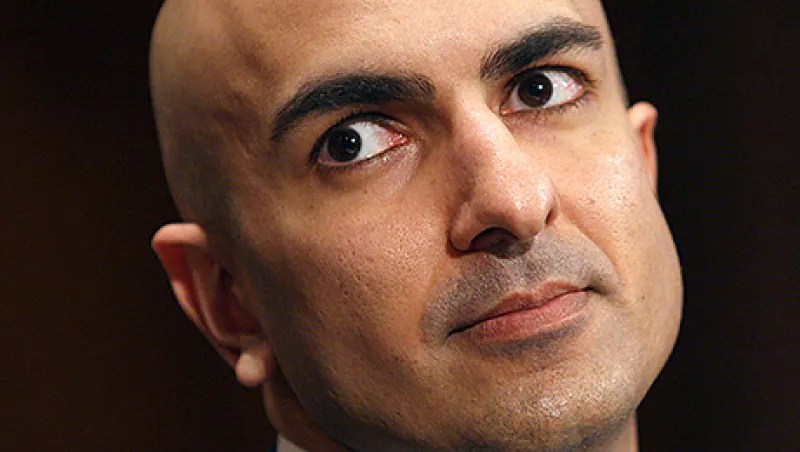In November the dusty world of U.S. monetary policy got a jolt of Gen X social media celebrity with the selection of Neel Kashkari — avid tweeter, hashtag aficionado — as the next president of the Federal Reserve Bank of Minneapolis. Appointments to the U.S. Federal Reserve Board can sometimes generate controversy, but usually within the relatively polite confines of academia or think tanks, from which most new members are drawn.
Under the Fed’s schedule of rotating votes, Kashkari will next be a voting member of the 12-person Federal Open Market Committee, which sets monetary policy, in 2017. For a central bank stuffed with economics and engineering Ph.D.s, his arrival comes as something of a shock.
Kashkari first leaped into the public consciousness in October 2008, when then–Treasury secretary Henry (Hank) Paulson Jr. appointed the former Goldman Sachs Group banker, 35 at the time, to run the federal government’s $700 billion Troubled Asset Relief Program. Now 42, Kashkari has since blazed a slightly frenzied trail through government and the private sector: He left Washington burned out after just seven months at the helm of TARP and moved to a cabin in the woods of northern California; he was head of the global equities desk at Pacific Investment Management Co. for four years starting in 2009; and in 2014 he ran as the Republican gubernatorial candidate in California, losing to incumbent Jerry Brown by almost 18 points.
In recent years Kashkari has maintained an energetic and opinionated presence on Twitter, which can’t be said of any of his peers-to-be on the FOMC; his latest tweets mix references to British pop singer Adele’s “God-given gift” and down-with-the-kids animated GIFs with links to the type of sober economic papers more conventionally associated with deep thinkers on monetary policy. If market watchers thought ex–Fed chair Ben Bernanke’s 2011 decision to hold press conferences following interest rate decisions was revolutionary, Kashkari, who takes over from outgoing Minneapolis Fed president Narayana Kocherlakota on January 1, promises to be something else entirely.
Getting a sense for Kashkari’s views on monetary policy and the function of the Federal Reserve, however, remains elusive. Much of the commentary in the wake of his appointment has focused on the growing number of FOMC members with ties to Goldman Sachs; William Dudley and Robert Kaplan, presidents of the New York and Dallas Feds, respectively, also worked at the storied investment bank.
Neil Barofsky, who as special inspector general overseeing TARP worked closely with Kashkari, described the incoming Minneapolis Fed president as “combative, not always forthcoming and excessively deferential to Wall Street” in his 2012 book, Bailout: An Inside Account of How Washington Abandoned Main Street While Rescuing Wall Street. Importantly, though, he added that Kashkari had a “deeply patriotic commitment to his job.”
Early critics blasted TARP as a risk-free handout to Wall Street, but the path eventually taken by the program, which had recouped all the assets loaned to troubled institutions at a small profit by the time it was shut down last year, suggests that Kashkari placed it on a footing less beholden to Wall Street than first feared.
But on the most crucial policy question he will face in his new job — whether the Fed should keep rates at zero or begin a hiking cycle — Kashkari, judging by his few tweets on the matter, appears to hold a view close to that of many in the financial industry: that monetary stimulus is a form of “morphine” from which an addicted market needs to be unhooked before it’s too late.
Following Kashkari’s appointment, economist Paul Krugman lambasted the former TARP head on his blog as a “liquidationist” who doesn’t understand the function and value of countercyclical monetary stimulus in boosting demand. Krugman surveyed Kashkari’s few recent tweets on quantitative easing, including one that claimed postcrisis “growth was artificially fast due to leveraging” of the economy.
Krugman’s response? “In the words of Charlie Brown, AAUGH!” In his new job, Kashkari will need more than hashtags and animated GIFs to win over the skeptics.







